Incident And Emergency Management Market Size and Share
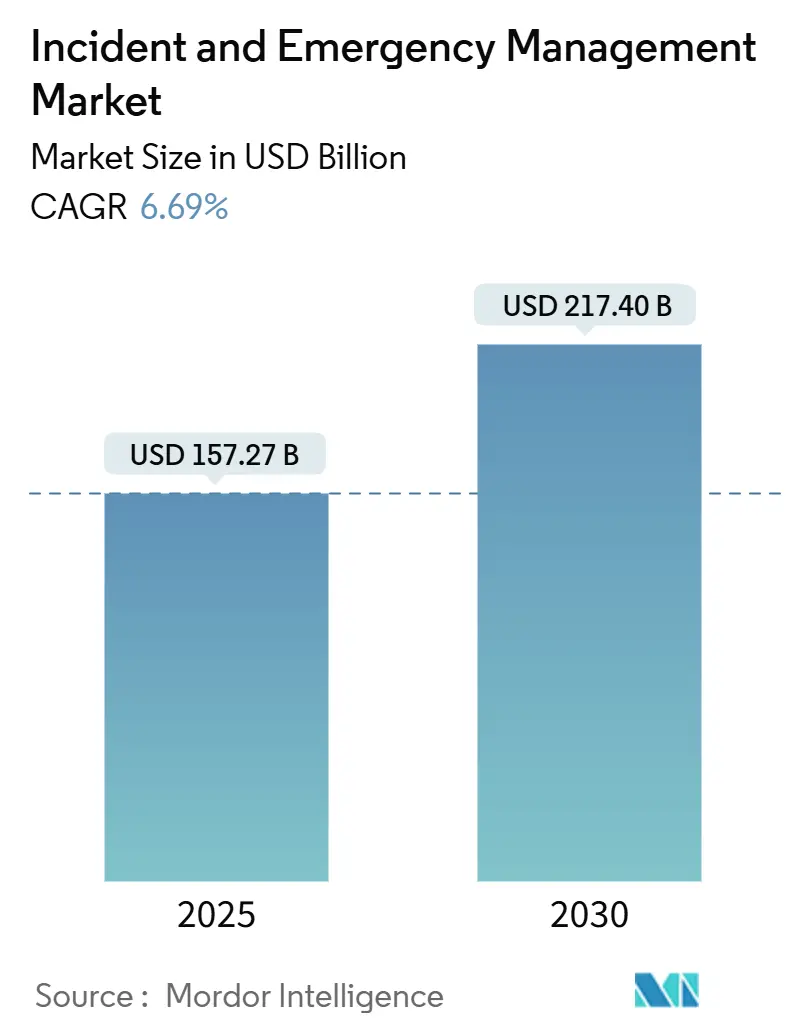
Incident And Emergency Management Market Analysis by Mordor Intelligence
The incident and emergency management market size is valued at USD 157.27 billion in 2025 and is forecast to reach USD 217.40 billion by 2030, reflecting a steady 6.69% CAGR over the period. This trajectory mirrors the rapid institutionalisation of emergency-preparedness budgets in both the public and private sectors, coupled with rising weather-driven disasters that command more comprehensive, technology-enabled response capabilities. North America maintains a broad lead on account of sophisticated federal funding programmes, while Asia registers the fastest expansion as governments upgrade early-warning and mass-notification infrastructures. Demand pivots toward integrated platforms that fuse geospatial analytics, cloud-native architectures, and AI-driven decision support, shortening the time between detection and coordinated field action. Intensifying cyber-physical threats and the migration of traffic and public-safety controls into smart-city fabrics round out the near-term growth catalysts.
Key Report Takeaways
- By component, the Solutions segment commanded 55% of the incident and emergency management market share in 2024, while Simulation & Training expanded at a 7.8% CAGR through 2030.
- By solution type, Emergency/Mass Notification held 28% revenue share in 2024; Surveillance & Security Monitoring is projected to grow at 8.5% CAGR to 2030.
- By service type, Professional Services accounted for 62% of the segment’s incident and emergency management market size in 2024; Managed Services leads growth at 7.2% CAGR.
- By communication system, First-Responder Communication systems dominated with 40% share in 2024; Satellite Communication Devices are set to advance at 8.6% CAGR.
- By simulation module, Traffic Simulation Software captured 38% of the incident and emergency management market size in 2024, while Hazard Propagation & Evacuation Modeling rose at a 8.4% CAGR.
- By end-user vertical, Government & Defense held 37% revenue share in 2024; Healthcare logs the highest CAGR at 6.5% through 2030.
- By geography, North America led with 42% market share in 2024; Asia delivers the fastest regional CAGR of 8.3% out to 2030.
Global Incident And Emergency Management Market Trends and Insights
Drivers Impact Analysis
| Driver | (~) % Impact on CAGR Forecast | Geographic Relevance | Impact Timeline |
|---|---|---|---|
| Escalating climate-related mega-disasters | +1.8% | North America, Asia, spillover global | Long term (≥ 4 years) |
| Mandated public alerting compliance | +1.2% | North America, Europe | Medium term (2-4 years) |
| AI-powered geospatial analytics adoption | +1.5% | Global; early uptake in North America & Europe | Medium term (2-4 years) |
| Rising cyber-physical attacks on critical infrastructure | +0.9% | Global; concentration in North America & Europe | Short term (≤ 2 years) |
| Smart-city traffic & emergency-control convergence | +0.7% | Asia, Europe, North America | Medium term (2-4 years) |
| Risk-based insurance incentives | +0.5% | North America, Europe | Medium term (2-4 years) |
| Source: Mordor Intelligence | |||
Increasing frequency and severity of climate-related mega-disasters
Economic losses from natural catastrophes reached USD 320 billion in 2024, with North America absorbing roughly 60% and Asia Pacific recording 79 hydro-meteorological events, spotlighting preparedness gaps. Rising loss ratios push governments and enterprises to procure multi-hazard early-warning networks, cloud-based incident dashboards, and satellite-enabled situational-awareness feeds. Development lenders such as the World Bank-hosted GFDRR underwrite capacity-building grants, anchoring multi-year procurement pipelines that fortify the incident and emergency management market.[1]Global Facility for Disaster Reduction and Recovery. "Annual Report 2024", gfdrr.org
Mandated compliance with public alerting standards (FEMA IPAWS, EU EECC)
Legislation now obliges telecom operators and public agencies to support authenticated cell-broadcast and multimodal warnings, accelerating mass-notification deployments. FEMA’s IPAWS benchmarks spurred heavy county-level adoption in the United States, while the EU’s Electronic Communications Code has set a 2025 deadline for continent-wide alerting reach. France’s upcoming mission-critical broadband network illustrates how spectrum migration unlocks richer media—location-pinpointed texts, images, and short videos—that heighten public responsiveness during crises.
Adoption of AI-powered geospatial analytics for real-time situational awareness upgrades
Machine-learning models are calibrating flood extents, wildfire spread, and infrastructure damage within minutes of satellite pass-overs. Cambodia’s WFP pilot and FEMA’s six internal AI use cases showcase cost-effective scaling of big-data processing across emerging and mature economies alike.[2]World Food Programme, “Climatic Disaster Risk Assessment in Cambodia,” wfp.org Decision-makers gain heat-mapped risk overlays and auto-generated resource-dispatch recommendations, stiffening the incident and emergency management market’s value proposition.
Escalating cyber-physical attacks on critical infrastructure
Accelerating threat actor sophistication blurs the line between IT and OT risk, compelling utilities, municipalities, and hospital systems to unify security operations centres with emergency operations centres. US policy papers now prioritise AI threat detection and supply-chain vulnerabilities, moving organisations to procure orchestration platforms that ingest both network-telemetry and physical-sensor inputs.[3]U.S. Department of Homeland Security, “Strategic Guidance and National Priorities 2024-2025,” dhs.gov This convergence fuels integrated procurement across what were once siloed budgets.
Restraints Impact Analysis
| Restraint | (~) % Impact on CAGR Forecast | Geographic Relevance | Impact Timeline |
|---|---|---|---|
| Interoperability gaps between legacy P25/TETRA and IP networks | -0.8% | Europe; minor spillover North America | Medium term (2-4 years) |
| High CapEx for resilient communications in remote APAC & island states | -0.6% | Asia-Pacific, global islands | Long term (≥ 4 years) |
| Data-privacy regulations curbing location-based alerts | -0.5% | Europe, North America | Medium term (2-4 years) |
| Shortage of systems-integration talent | -0.4% | Global; acute in developing regions | Short term (≤ 2 years) |
| Source: Mordor Intelligence | |||
Interoperability gaps between legacy P25/TETRA networks and IP-based platforms
Many European public-safety agencies still depend on narrowband P25 or TETRA radios that operate on proprietary protocols, hampering seamless roaming onto broadband cellular or satellite links. SAFECOM grant guidance presses states to adopt standards-based bridging technologies, yet funding and procurement cycles slow roll-out of converged solution. The resulting patchwork delays cross-border coordination and marginally dampens the incident and emergency management market’s near-term growth.
High CapEx for resilient communications in remote APAC and island nations
Sparse population densities and rugged topographies require expensive satellite backhaul or microwave redundancy, stretching public-sector budgets. Although Australia’s Disaster Ready Fund allocates USD 1 billion over five years, many Pacific islands still rely on grant financing to establish minimum-viable command-and-control nodes.[4]National Emergency Management Agency, “Disaster Ready Fund,” nema.gov.auSlower infrastructure roll-out tempers demand for advanced software layers.
Segment Analysis
By Component: Solutions Dominate While Simulation & Training Gains Momentum
Solutions generated 55% of the incident and emergency management market in 2024, a testament to buyer preference for end-to-end platforms that orchestrate alerting, resource allocation, and after-action reporting in a single pane of glass. Rapid upgrades to AI engines and cloud elasticity underpin continued wallet share expansion. Vendors accentuate open-API ecosystems that plug into CAD, GIS, and EOC modules, improving time-to-value for regional agencies. Over the forecast horizon, tighter integration with insurance-risk scoring tools will further entrench platform revenues.
Simulation & Training, though smaller in absolute revenue, is scaling at 7.8% CAGR as agencies institutionalise scenario-based preparedness policies. Gamified modules such as George Mason University’s AI-augmented “Go-Repair” illustrate how immersive learning cuts attrition and raises competence, thereby elevating training budgets. This segment’s expansion feeds a virtuous cycle: stronger preparedness metrics qualify states for resilience grants, reinforcing upstream demand for platform solutions.
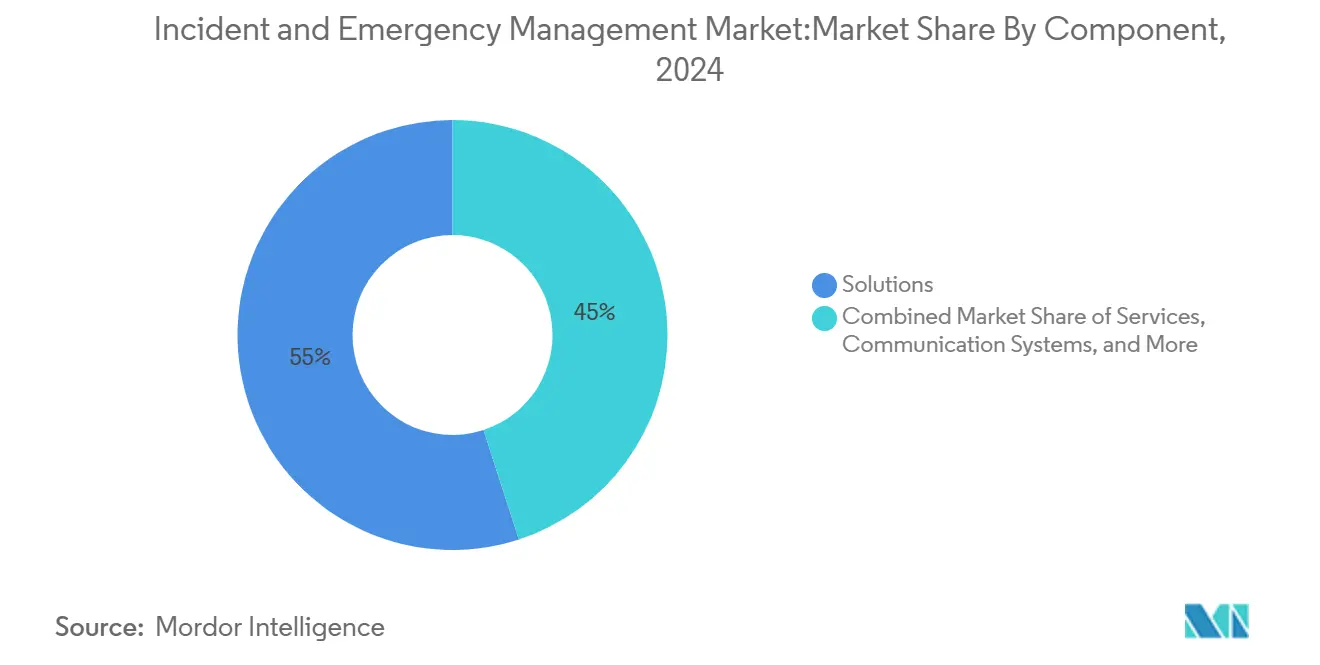
Note: Segment shares of all individual segments available upon report purchase
By Solution Type: Surveillance & Security Monitoring Accelerates Digital Transformation
Emergency/Mass Notification continues to anchor 28% of 2024 revenue as regulated mandates lock in upgrade cycles. However, Surveillance & Security Monitoring is the fastest-moving niche at 8.5% CAGR, propelled by AI-driven video analytics and object detection that shorten dispatch times. Video feeds now integrate directly into 911 centres, producing a continuous intelligence loop that amplifies situational clarity and responder safety. Over the outlook period, the incident and emergency management market size attached to this sub-segment could exceed USD 35 billion if municipal vision-zero programmes accelerate as projected.
Traffic & Incident Management rides urban-mobility investments, whereas CBRNE/HazMat Detection broadens sensor deployment via unmanned aerial systems that minimise human exposure. Disaster Recovery & Backup solutions play a crucial role, mitigating secondary business-interruption costs.
By Service Type: Managed Services Redefine Delivery Models
Professional Services constitute 62% of the segment-level incident and emergency management market size in 2024, spotlighting advisory, integration, and compliance support that most agencies cannot staff internally. Consulting teams translate doctrine into workflows, then blueprint cross-agency interoperability matrices. Yet Managed Services, expanding at 7.2% CAGR, signal a structural shift toward outsourcing operational burdens. Providers bundle 24/7 network operations, patch management, and cyber-monitoring into subscription contracts that smooth opex for municipalities.
Training & Education continues to mature, leveraging VR headsets and digital twins to replicate complex, low-frequency events. Such immersive curricula lower simulation costs per trainee and unlock repeatable skill refresh cycles. Support & Maintenance revenues remain sticky, driven by guaranteed SLA clauses embedded in multi-year framework agreements.
By Communication System: Satellite Connectivity Extends Reach
First-Responder Communication networks, primarily P25 and TETRA, held 40% of the 2024 spend and remain indispensable for mission-critical voice. Modernisation roadmaps layer LTE or private-5G backbones onto LMR cores, guided by documents such as Indiana’s Tactical Interoperable Communications Plan that codify resiliency playbooks. The incident and emergency management market size tied to Satellite Communication Devices is scaling at 8.6% CAGR as agencies ensure against last-mile outages during hurricanes and wildfires.
Emergency Radios preserve niche relevance for volunteer agencies, while vehicle-mounted MDTs merge CAD, mapping, and telematics into frontline workflows. Drone-fed situational awareness layers live video, orthomosaics, and gas-sensor telemetry into unified incident consoles, reinforcing end-to-end visibility for commanders.
By Simulation Module: Hazard Propagation Modeling Gains Prominence
Traffic Simulation Software captured 38% market share in 2024, undergirding evacuation and contraflow planning for coastal metros. Hazard Propagation & Evacuation Modeling, growing at 8.4% CAGR, benefits from wildfire-spread and toxic-plume engines that inform micro-zonal shelter-in-place orders. WHO’s emphasis on simulation exercises validates recurring procurement of these tools as part of preparedness scorecards.
Incident Command Training Simulators exploit AI to adjust difficulty dynamically, ensuring decision-makers confront cascading-failure scenarios absent in static tabletop drills. The EMI’s virtual tabletop series converts this content into cloud-hosted workshops, democratising access for under-resourced jurisdictions.
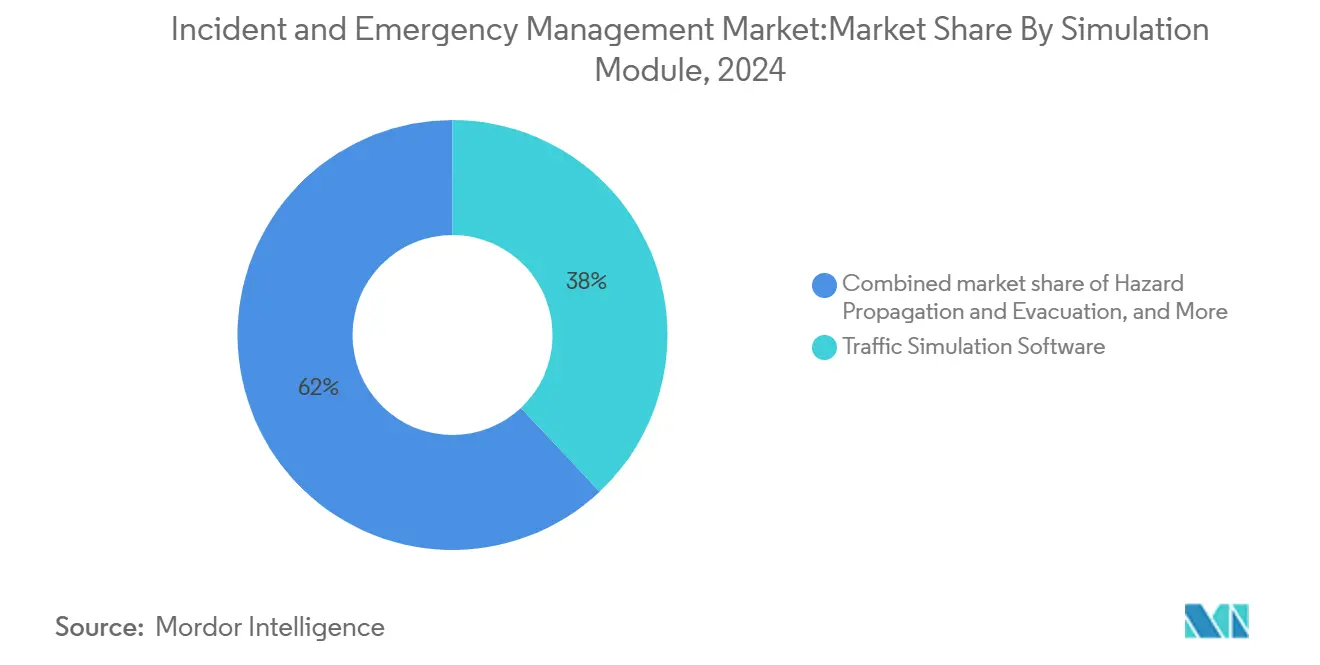
Note: Segment shares of all individual segments available upon report purchase
By End-User Vertical: Healthcare Adoption Accelerates
Government & Defense agencies retain a 37% share by virtue of statutory response mandates and federal grant inflows. Procurement frameworks such as FEMA’s USD 33.1 billion 2025 budget cement multi-year platform contracts. The Healthcare vertical outpaces all others at 6.5% CAGR, integrating digital twins that map facility capacity, resource burn-down, and patient evacuation logistics, thereby reducing morbidity during surge events.
Energy & Utilities step up grid-resilience investments, while Transportation & Logistics stakeholders channel funds into TIM and supply-chain continuity analytics. BFSI, Manufacturing, Aviation, Maritime, Mining, and Oil & Gas each adopt tailored modules that reflect distinctive risk topographies.
Geography Analysis
North America anchors 42% of 2024 revenue, sustained by FEMA grants, private-sector cyber-investment, and wide FirstNet penetration. US counties align on interoperable protocols, and Canada’s DFAA framework pairs fiscal backstops with modernisation commitments, cultivating a mature ecosystem of suppliers, systems integrators, and academia. Pilot deployments of tethered drones for TIM lend tangible proof points that reinforce municipal budget renewals.
Asia delivers a 7.3% CAGR, spurred by megacities’ exposure to typhoons and seismic risk. China overlays city-wide HD camera grids onto command centres, and Japan’s J-ALERT system extends real-time hazard feeds to the public. India leverages AI-driven geospatial platforms to triage relief corridors after cyclones, elevating enterprise spending on emergency operations centres. Multilateral funding via ADB’s Disaster Risk Management Action Plan catalyses procurement in ASEAN markets.
Europe sustains steady replacement cycles as the EECC compliance clock counts down. Projects such as BroadWay pilot cross-border roaming for first responders, driving solution providers to embed secure SIM credentialing and quality of service tiers. Meanwhile, the Middle East and Africa witness incremental adoption as humanitarian-relief agencies and national security bodies standardise on early-warning analytics to counter compound drought and conflict risks.
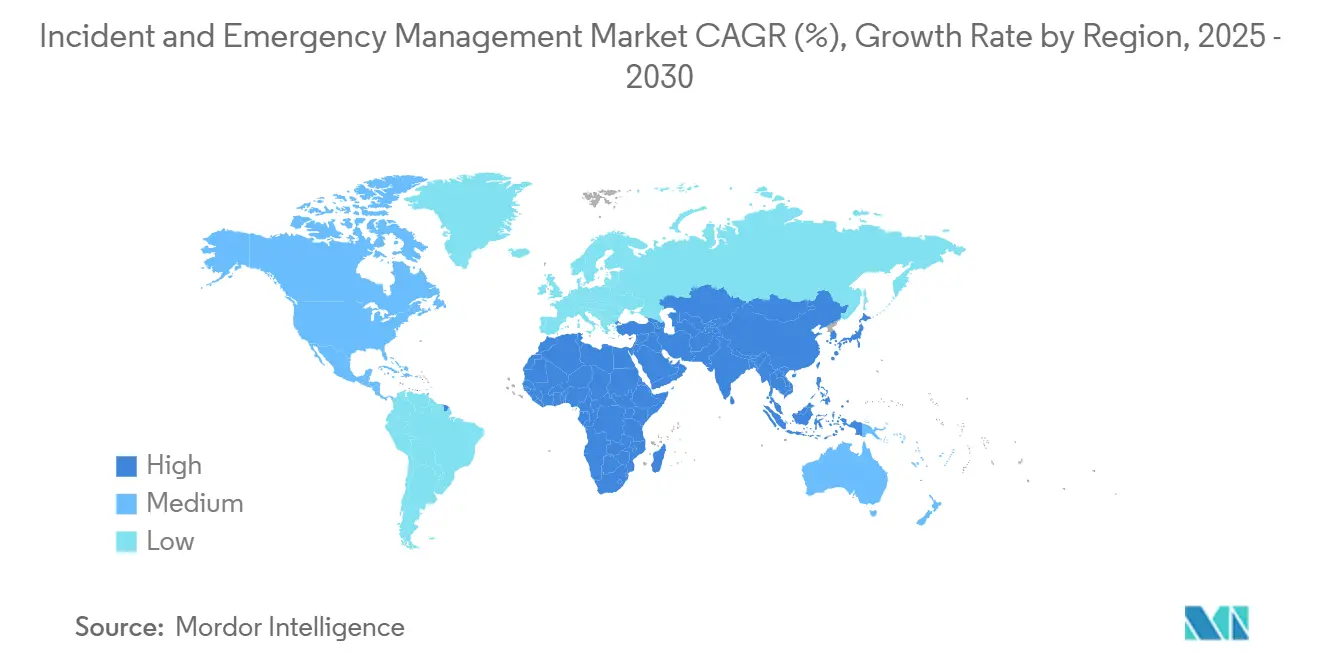
Competitive Landscape
The incident and emergency management market exhibits moderate fragmentation, with Honeywell International, Motorola Solutions, and Hexagon AB retaining brand primacy through M&A and AI feature releases. Motorola’s DIMETRA Connect enabling automatic LMR-to-broadband roaming exemplifies product-line extension that shores up installed-base loyalty. Hexagon’s 2025 platform refresh layers predictive analytics onto call-taking workflows, striving for first-mover advantage in AI-guided dispatch.
Cloud hyperscalers and data-science boutiques gain traction, partnering to deliver pay-per-use GIS or drone-intelligence modules. Ecosystem alliances—software ISVs with satellite operators, or insurers with EOC vendors—differentiate offerings on outcome-based KPIs such as response-time reduction or insured-loss avoidance. Emerging challengers leverage mobile-first architectures and low-code configuration to undercut incumbents’ long deployment cycles, although market-entry barriers remain high where regulatory accreditation is mandatory.
Vendor strategy increasingly pivots to platform monetisation: upsell adjacent modules, embed managed services, and lock recurring revenue via subscription licensing. Portfolio coherence, cybersecurity hardening, and standards-compliance roadmaps drive competitive advantage, signalling continued consolidation as private equity funds target niche analytical or sensor-hardware specialists.
Incident And Emergency Management Industry Leaders
-
IBM Corporation
-
Honeywell International Inc.
-
NEC Corporation
-
Hexagon AB
-
The Response Group
- *Disclaimer: Major Players sorted in no particular order
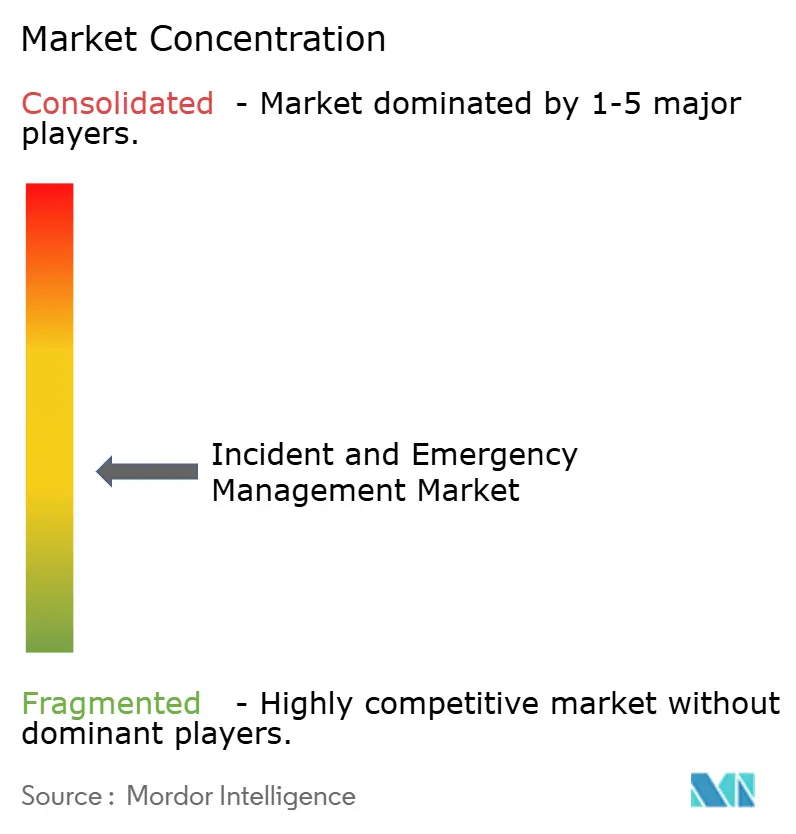
Recent Industry Developments
- March 2025: Motorola Solutions acquired a public-safety software vendor to deepen its incident-response stack and cross-sell into its LMR install base.
- February 2025: Hexagon AB released an AI-infused emergency-management platform upgrade aimed at increasing dispatcher decision velocity.
- January 2025: IBM unveiled automated failover in its disaster-recovery suite, pairing hybrid-cloud resilience with command-centre orchestration.
- December 2024: Everbridge formed a telecom alliance to extend multichannel notification reach, bolstering message-delivery SLA guarantees.
Research Methodology Framework and Report Scope
Market Definitions and Key Coverage
Our study defines the global incident and emergency management market as all software platforms, communication devices, simulation tools, and professional services that help public or private actors prepare for, detect, respond to, and recover from natural or man-made crises, measured by annual vendor revenue. According to Mordor Intelligence, the market reached USD 157.27 billion in 2025.
Scope Exclusions: We exclude stand-alone cyber incident response software sold outside integrated emergency frameworks and day-to-day facilities maintenance services.
Segmentation Overview
- By Component
- Solutions
- Services
- Communication Systems
- Simulation and Training
- By Solution Type
- Emergency/Mass Notification
- Surveillance and Security Monitoring
- Traffic and Incident Management
- Disaster Recovery and Backup
- CBRNE/HazMat Detection Systems
- Public Information Management
- By Service Type
- Professional Services
- Consulting and Advisory
- Training and Education
- System Integration and Deployment
- Managed Services
- Support and Maintenance
- By Communication System
- First-Responder Communication (P25, TETRA)
- Emergency Radios and Satellite Phones
- Vehicle-Mounted Mobile Data Terminals
- Drones and Robotics for Situational Awareness
- By Simulation Module
- Traffic Simulation Software
- Hazard Propagation and Evacuation Modeling
- Incident Command Training Simulators
- By End-User Vertical
- Government and Defense
- Energy and Utilities
- Healthcare
- BFSI
- Transportation and Logistics
- IT and Telecom
- Manufacturing and Industrial
- Aviation and Maritime
- Mining and Oil and Gas
- Media and Entertainment
- By Geography
- North America
- United States
- Canada
- Mexico
- South America
- Brazil
- Rest of South America
- Europe
- United Kingdom
- Germany
- France
- Nordics
- Rest of Europe
- APAC
- China
- Japan
- India
- South Korea
- ASEAN
- Australia
- New Zealand
- Rest of APAC
- Middle East and Africa
- Saudi Arabia
- United Arab Emirates
- South Africa
- Rest of Middle East and Africa
- North America
Detailed Research Methodology and Data Validation
Primary Research
Our analysts interviewed emergency service chiefs, city resilience officers, solution integrators, and platform vendors across North America, Europe, Asia-Pacific, Latin America, and the Middle East to confirm spending patterns, typical contract sizes, and forecast assumptions.
Desk Research
We gathered baseline evidence from open repositories such as FEMA IPAWS alert statistics, the UNDRR loss database, EM-DAT disaster tallies, World Bank infrastructure dashboards, and trade associations like the International Association of Emergency Managers. Company filings, 10-Ks, and investor decks supplied revenue clues that were enriched through D&B Hoovers, Dow Jones Factiva, and Questel patent analytics to trace technology diffusion. Regional regulations (for example, EU EECC and US NFPA standards) further clarified addressable scope. This list is illustrative, and many additional publications informed data collection, validation, and contextual understanding.
Market-Sizing & Forecasting
We begin with a top-down reconstruction that scales government disaster management budgets, humanitarian aid flows, and infrastructure protection outlays to global totals. We then apply penetration-rate based demand pools for private sector adoption. Supplier roll-ups of sampled average selling price multiplied by shipment volumes, plus channel checks, provide bottom-up cross validation. Any gap beyond tolerance triggers assumption adjustments. Variables such as the yearly count of FEMA-classified disasters, urban population density, first responder headcount, cloud migration rates of mass notification platforms, and sensor kit prices feed a multivariate regression blended with ARIMA for projections through 2030. Where vendor segmentation is opaque, nearest neighbor averages from disclosed peers bridge data holes before final triangulation.
Data Validation & Update Cycle
We run anomaly checks against independent indicators, hold multi-step analyst reviews, and re-contact select sources when discrepancies emerge. Models refresh every twelve months, with interim updates after material events. Only after all variances are reconciled do we lock the baseline for publication.
Why Mordor's Incident And Emergency Management Baseline Commands Credibility
Published estimates often vary, and we observe that differing scopes, refresh cadences, and currency years drive much of the gap.
Key Gap Drivers include exclusion of simulation and training revenues by some providers, conservative service life assumptions, outdated exchange rates, and reliance on optimistic scenarios that lack primary cross checks.
Benchmark comparison
| Market Size | Anonymized source | Primary gap driver |
|---|---|---|
| USD 157.27 B (2025) | Mordor Intelligence | |
| USD 131.92 B (2024) | Global Consultancy A | Omits simulation and training streams, older base year |
| USD 137.45 B (2024) | Global Consultancy B | Excludes communication devices, static exchange rates |
| USD 159.70 B (2025) | Industry Journal C | Relies on vendor survey without budget triangulation |
Taken together, we believe Mordor's disciplined scope selection, mixed method modeling, and timely refresh give decision makers a balanced, transparent baseline they can retrace and replicate with confidence.
Key Questions Answered in the Report
What is the current size of the incident and emergency management market?
The market stands at USD 157.27 billion in 2025 and is projected to reach USD 217.40 billion by 2030 at a 6.69% CAGR.
Which region leads the incident and emergency management market?
North America leads with 42% revenue share, supported by robust federal funding and advanced technology adoption.
Which segment shows the fastest growth?
Surveillance & Security Monitoring solutions grow at 8.5% CAGR, driven by AI-enabled video analytics and real-time situational awareness.
Why is the healthcare vertical expanding rapidly?
Hospitals adopt digital-twin and resilience tools to manage surge capacity and emergency workflows, resulting in a 6.5% CAGR from 2025-2030.
How are insurers influencing investment decisions?
Risk-based premium incentives encourage enterprises to build emergency-operations centres, aligning preparedness with lower insurance costs.
What technologies are shaping future emergency management platforms?
AI-powered geospatial analytics, satellite connectivity, drone-based reconnaissance, and cloud-native command-centre software dominate roadmaps.
Page last updated on:



